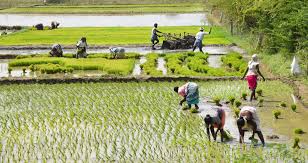Dry weather becoming a hurdle for direct seeded rice cultivation in Haryana
By Pawan Sharma
The unusually dry weather conditions are likely to pose a major challenge to Haryana agriculture and farmers welfare department to achieve the target of growing rice in three lakh- acre area during this kharif cycle using the less water consuming method called direct-seeded rice (DSR), it has emerged.
In Haryana, a farmer opting for DSR scheme gets ₹4,000 per acre incentive, besides a subsidy for buying a DSR machine.
Basmati rice can be grown as DSR under un-puddle conditions as it helps in saving soil and water resources along with less dependence on labour.
Paddy is cultivated across 30-35 lakh acre in Haryana. Officials say water up to 3,700-4,200 litre is used to produce 1 kg of rough rice through the traditional practice of transplantation that involves intensive use of water.
Ever since Haryana government introduced this monetary incentive -linked DSR technique in 2021 to conserve ground water, the scheme found favour among the cultivators.
From growing paddy through DSR in 17,444-acre in 2021, the verified area grew to 72,900-acre in 2022 and it further rose to 1.76 lakh acre in kharif 2023.
“It seems that due to the dry weather conditions, we may not achieve our target of bringing 3 lakh- acre under DSR this kharif,” said Rajnarayan Kaushik, director of Haryana agriculture and farmers welfare department.
“As per reports from the field, the cultivators are coming across some problems related to DSR due to prevailing weather this year. We are monitoring the situation on daily basis and taking necessary steps.”
As per the DSR registration status report till July 4, the highest 6,739 farmers in Sirsa district have registered 53,605- acre followed by Fatehabad (farmers: 1,524, land: 10,713- acre), Yamunanagaar (farmers: 1,126, land: 4,937- acre), Karnal (farmers: 1,003, land: 7,632- acre), Jind (farmers: 668, land: 4,077- acre), Kurukshetra (farmers: 825, land: 3,436-acre), Ambala (farmers: 697, land: 2,881- acre), Hisar (farmers: 286, land: 1,450-acre), Kaithal (farmers: 512, land: 2,717- acre), Panipat ( farmers: 87, land: 490- acre), Sonepat (farmers: 332, land: 2,281) and in Rohtak district 70 cultivators have registered 445- acre.
The officials say the process of registration of land for DSR scheme is still underway.
In 2021, when this first of its kind incentive-driven DSR scheme was conceived and implemented by the then additional chief secretary (ACS-agriculture) Sumita Misra, farmers of eight districts of Haryana grew paddy on 17,444 acre against the target of 20,000-acre under the watch of experts.
This scheme was first implemented in Ambala, Yamunanagar, Karnal, Kurukshetra, Kaithal, Panipat, Sonepat and Jind districts. About ₹9 crore was disbursed to 8,627 farmers at the rate of ₹5,000 per acre through DBT for verified areas.
Initially, each farmer opting for this scheme was allowed to grow the crop using DSR technique on a maximum 2.5 acre. This piece of land was called a ‘demonstration plot’ to popularise the technique among the peasants.
In 2022, an area of 72,900- acre was achieved under DSR against the target of 1 lakh acre and over ₹ 29 crore was transferred directly to the bank accounts of 16,641 farmers at the rate of ₹4,000 per acre for the verified area, as per official data.
Director agriculture Rajnarayan Kaushik said that in kharif 2023 a target of 2 lakh acre under DSR was fixed for 12 districts. The state government sanctioned budget of ₹80 crore under “Promotion of Crop Diversification and Water Conservation” in 2023-24.
After the rigorous verifications, he said, it emerged that 38,427 farmers grew paddy with DSR method in 1.76 lakh acre last year.
“The money is released to the farmers directly after field verifications by the agriculture department’s committees. A few remaining DSR payments of farmers related to last year will be released within this month,” said Kaushik.
Benefits of DSR
The officials say promoting DSR has become imperative to curtail “over exploitation of natural resources”.
“DSR is an important resource conserving technology for saving the water and soil resources and 20% water is saved under DSR cultivation,” officials say, adding direct seeding of basmati varieties and hybrids of paddy improved water saving, reduced labour cost considerably with higher net returns compared to puddle transplanted paddy.
As per government records, during 2022 kharif season the paddy cultivation in 72,000 acres with DSR technique saved 31,500 crore litres of water.
Haryana produces 68 lakh metric tonnes (MT) of paddy, including around 20 lakh MT basmati. Over 9 lakh farmers register themselves regularly on Meri Fasal Mera Byora (MFMB) web portal of the state government, making it easier for the government to undertake different pro-farmer initiatives, including financial support via DBT for DSR promotion.
This article has been republished from The Hindustan Times.

